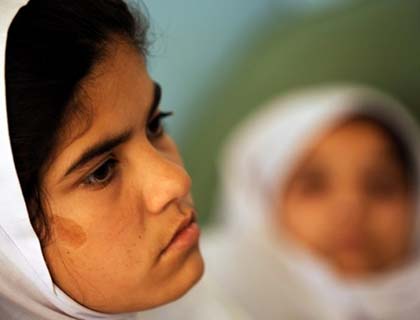Based on a survey, “Focusing on getting children in school, particularly girls, and keeping them there seemed appropriate looking at early enrolment figures. In 2001, fewer than one million Afghan children went to school. Since, their number has increased to 8.5 million in 2012/2013 (5.2 million boys and 3.3 million girls). However, over one million of those enrolled are permanently absent. And still “only 55% of children of primary school age are attending school.”
Staff at Kabul University says they do not have “a single Afghani for its central library,” and neither do faculties have money to stock their own, smaller libraries, and the same applies to provincial universities’ libraries.
A look at the running-costs budget for higher education with one of the finance managers at the ministry shows why. Reportedly, the running costs budget comes in three pots. The largest portion of around 37,898,400 million dollars is set aside mostly for salaries. The second pot of 30,792,400 US dollars mostly covers the costs for dormitories, food for students, furniture, water, electricity, etc. The third pot of 215,332 US dollars covers smaller purchases or repairs.
It is the second part of the budget that, in a sub-category, details a budget for purchasing books. It is a tiny pot, with 34,453 dollars for all 34 Afghan universities – thus basically allotting 1,000 dollars to each university for purchasing books. And no regulation obliges universities to actually spend the money on books. They could spend it on other items in this sub-category such as stationary, boards and the like or redirect it to requirements of the larger pot – possibly using it to pay power bills or maintain dorms.
Reliance on often random donations leaves libraries largely meaningless for students as the books do not fit professors’ lectures or the exams students face at the end of the semester.
A researcher quotes assistant head librarian Homayun as, “We do not have enough new books. We do not have enough copies of new books. We do not have enough books in Dari and Pashto. And our students’ English is not good enough to really understand the books we have in English.”
The largest barrier to new and better textbooks and other up-to-date resources for students is language, though. There is little quality material available in Dari or Pashto while students’ but also professors’ English is often too patchy to rely on English-language material. Material in English, however, is being promoted widely by the international community, simply because most international advisors helping to reform the sector either are native English speakers or are used to working in English.
This is not helpful in a system that suffers from a lack of English skills and in a country where around 50 per cent of all Afghans do not even read and write Dari or Pashto.
In some faculties, teachers are, since last year, directed to teach whole courses in English. This applies particularly to courses of study that the ministry and donors have identified as ‘priority fields’: engineering, computer sciences, medicine and public policy and administration. Teaching in English had already been suggested in the 2005 UNESCO development plan for the Ministry of Higher Education. But it must also be credited to former President Hamed Karzai’s repeated requests to teach courses in English “to facilitate economic development.” Karzai cited India, Iran and Pakistan as examples of countries “that have made huge advances in medicine and other important fields through such an international focus on learning.”
A researcher predicts that while looking ahead into such a desirable future with Afghan graduates competing on the world stage, it seems to have been simply overlooked that today’s Afghan students are just not there yet – and might not be for another ten years. It is because the English teaching in primary and secondary schools is still rudimentary and often produces students who are only able to say what their name is and where they come from.
Afghanistan’s future depends on the workforce it is building now. Not all young Afghans need a university degree to be useful, but those who do go to university should graduate as experts in their fields. This is currently not the case, also because there are, for most courses of study, few up-to-date resources in languages students understand. The higher education reform efforts of the past years have created the paradox that what is taught in many new buildings and new faculties is still ‘old hat.’
Over all, many professors are busy with multi-tasks and therefore attend universities as a sub-profession. Moreover, on the one hand they have lost their interests in teaching for having it a regular duty for 20 or more years, on the other hand the retired professors are still busy with teaching so as not to miss their salaries.
“The Afghan government should contribute by increasing the annual budget by the needed sums – at least. It might also be worth thinking about standardizing the existing new syllabi of Kabul faculties for all those sister-faculties in the provinces who have not yet revised their curricula in order to prevent the use of old and out-dated resources.”
The new government is supposed to bring a thorough structural change in educational system and university conditions. If the same trend continues, the universities will be no more than a machine which produces students with low quality. In short, the government has to focus more on quality rather than quantity and employ the expert and young resources of the society.

